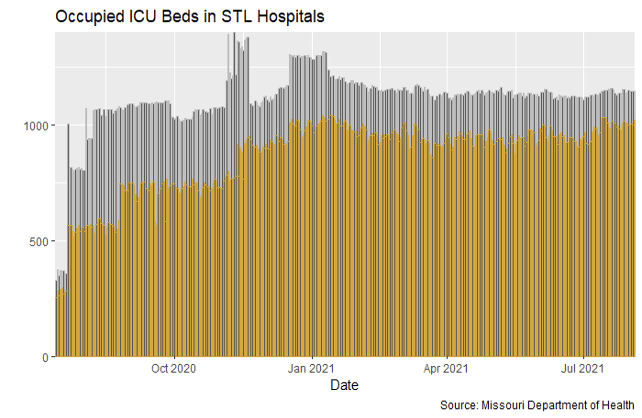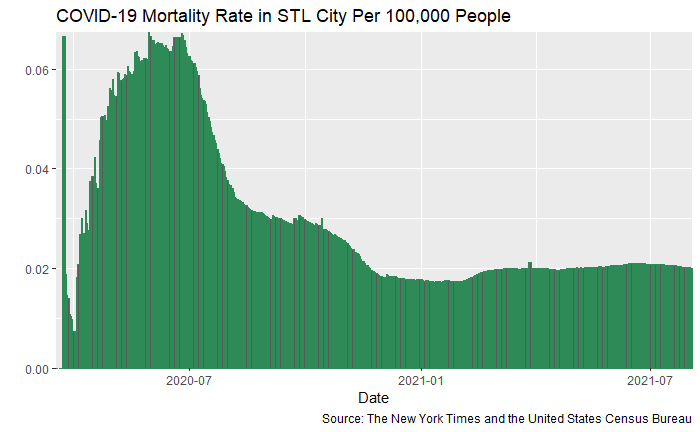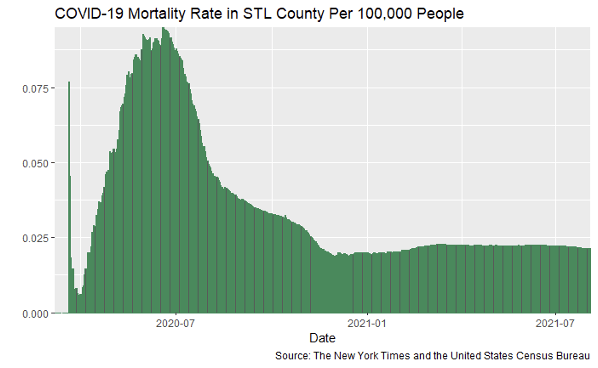How the Free Market is Doing Public Health Officials’ Jobs

On July 27 of this year, the Centers for Disease Control and Prevention (CDC) released a statement, advising the vaccinated public to “wear a mask indoors in public if you are in an area of substantial or high transmission.” Even before the CDC issued this statement, many places around the country already reintroduced mask mandates and more are following suit. Such is the case for parts of Missouri, like St. Louis County and City that implemented the mandate on July 26. The rationale behind the mask mandate sheds light on policymakers’ concerns. Dr. Fredrick Echols, the acting Director of Health for the City of St. Louis, told the public that “we could see spikes that overwhelm our hospital and public health systems.” While so far only a few cities and counties have reinstated a mask mandate, policymakers’ fears of the Delta variant could be used to justify further mask mandates around the United States.
Amid the increase of Covid-19 cases from the Delta variant, the main concern of St. Louis health officials is the possibility of local hospitals becoming overwhelmed, meaning they have more patients than hospital beds available. While the Delta variant is responsible for a majority of new Covid-19 cases, the risk of an overwhelmed healthcare system remains minute. To understand the healthcare scenario, a closer look at the data is required.
The first piece of relevant data is the amount of available ICU beds in St. Louis hospitals. The graph below depicts the spread between the total number of ICU beds (gray) and occupied ICU beds (gold). A peculiar aspect about the ICU beds in the gray graphs is that they are never constant.

Just like how a grocery store sells more candy during Halloween, a hospital supplies more medical care, along with the necessary supplies, such as ICU beds, when demand increases. As one can see in the graph, when experiencing or expecting a surge in occupied ICU beds, hospitals anticipated growing demand and increased the number of supplied ICU beds. Moreover, once demand for the beds subsided, the hospitals decreased the supply of ICU beds accordingly.
This raises questions about the reasoning and incentives behind the St. Louis Department of Public Health’s policy mandates and recommendations. If the hospitals already have ways to manage their supply of ICU beds to match the ever fluctuating demand, then why does a temporary increase in the supply of ICU beds warrant a non-market solution?
Perhaps their concern is actually about the death count of Covid-19 patients. The St. Louis Department of Public Health posits that “mask adherence is itself associated with a significant decrease in COVID-19 cases and deaths in all 50 states and D.C.” When one looks at the data, however, one sees that St. Louis, both city and county, are experiencing a decline in the mortality rate despite the absence of a mask mandate.
A visualization of The New York Times’ county-based Covid-19 data shows the mortality rate of patients with Covid-19 in both St. Louis City and County. The graph demonstrates that St. Louis has not seen a substantial difference in the Covid-19 mortality rate since the first mask mandate was lifted on May 14 of this year. So, if hospitals have their own means to support an influx of Covid-19 patients in the ICU and if the mortality rate has not increased post-mandate, then why does the Department of Health and its policymakers deem their actions necessary?


While the department cites masks as being helpful in reducing the spread of Covid-19, its claims that hospitals are being overwhelmed and mortality rates are increasing are misleading though useful in rationalizing their mandates. Moreover, even if hospitals are at risk of the shrinking spread between available and occupied ICU beds, there are market solutions to the problems that public health officials are otherwise trying to solve with legislation.
This ignorance of the capabilities of markets and their ability to allow individuals and businesses to find solutions to societal problems sets a worrisome precedent for the actions of public health officials going forward. Despite being among the first to reinstate a mask mandate, it is unlikely St. Louis will be the last city to attempt another one. Additionally, while the mandate in St. Louis has been temporarily repealed by a district judge, other counties and cities around the U.S. are adopting similar policies in light of the CDC’s new statement. Perhaps it will take some time, but there is still hope that US policymakers will recognize the advantages of market-based solutions instead of leaning on continuous mandates.










